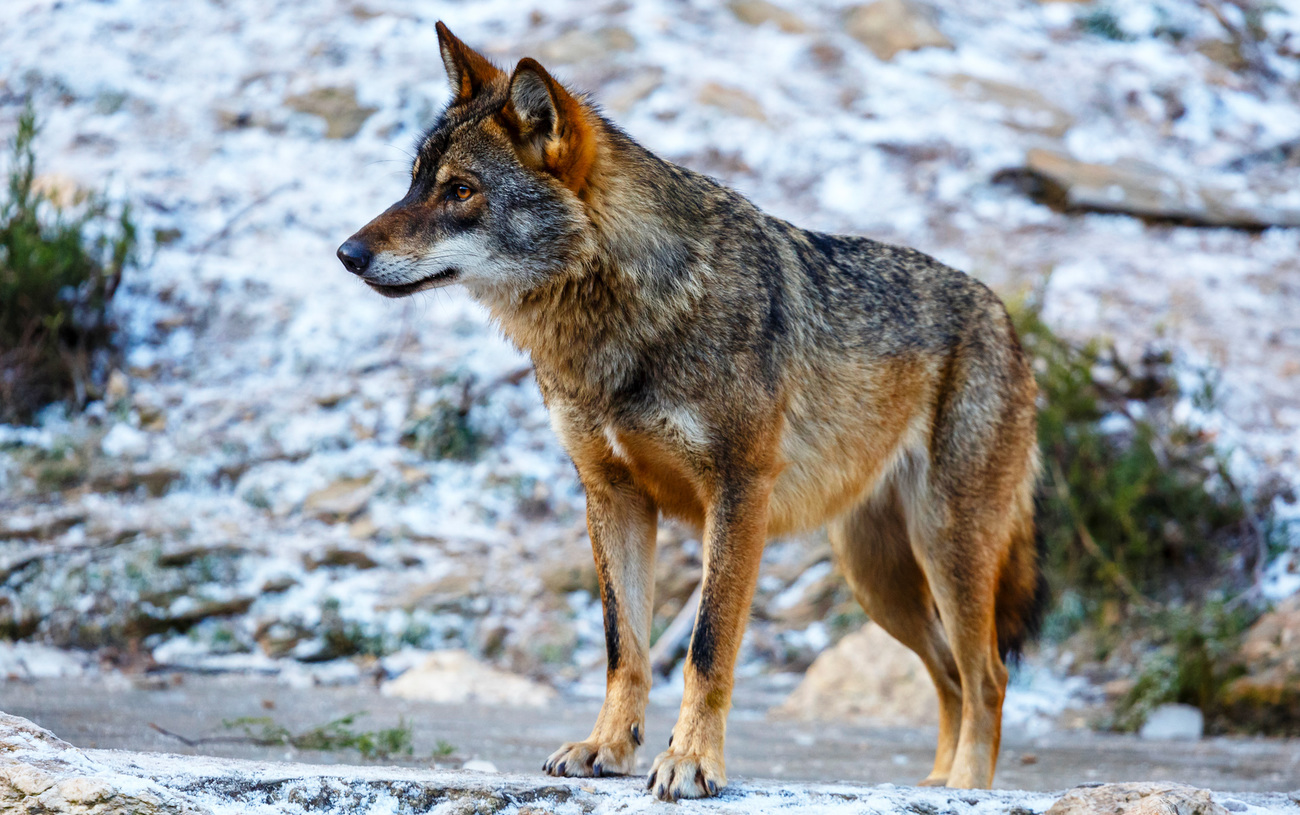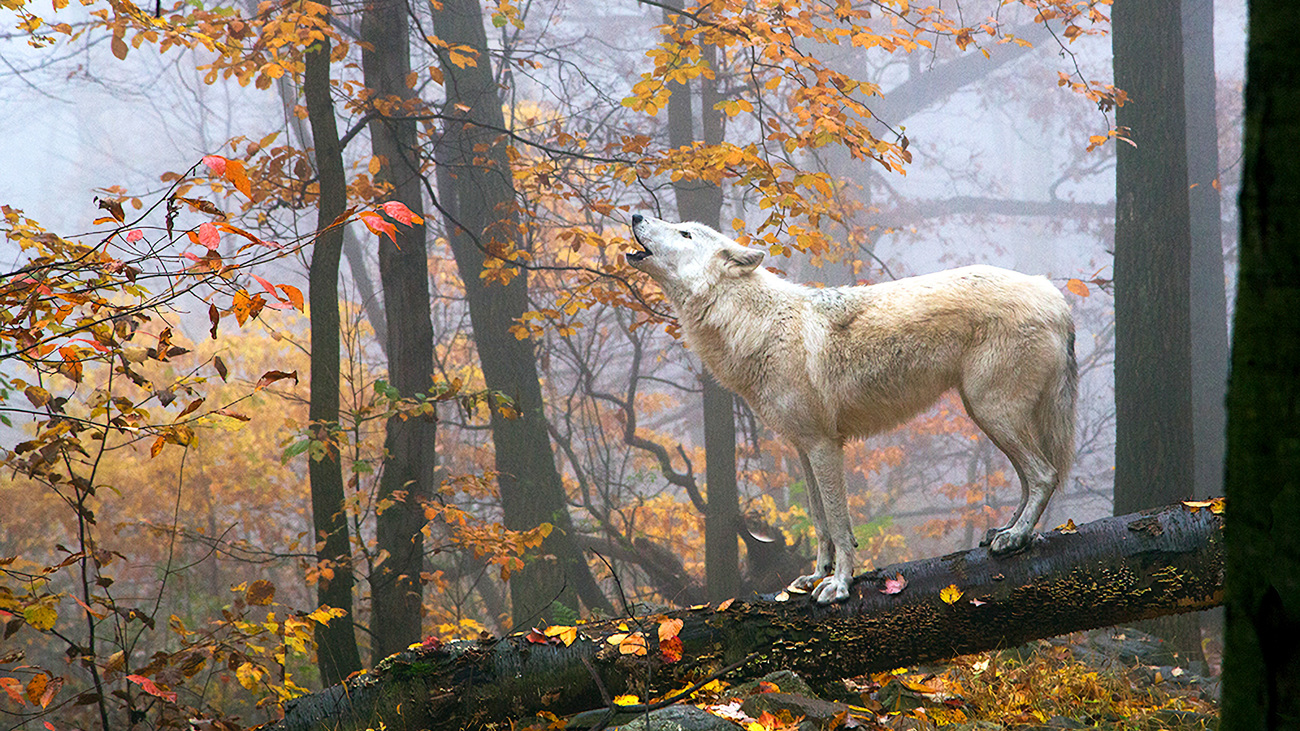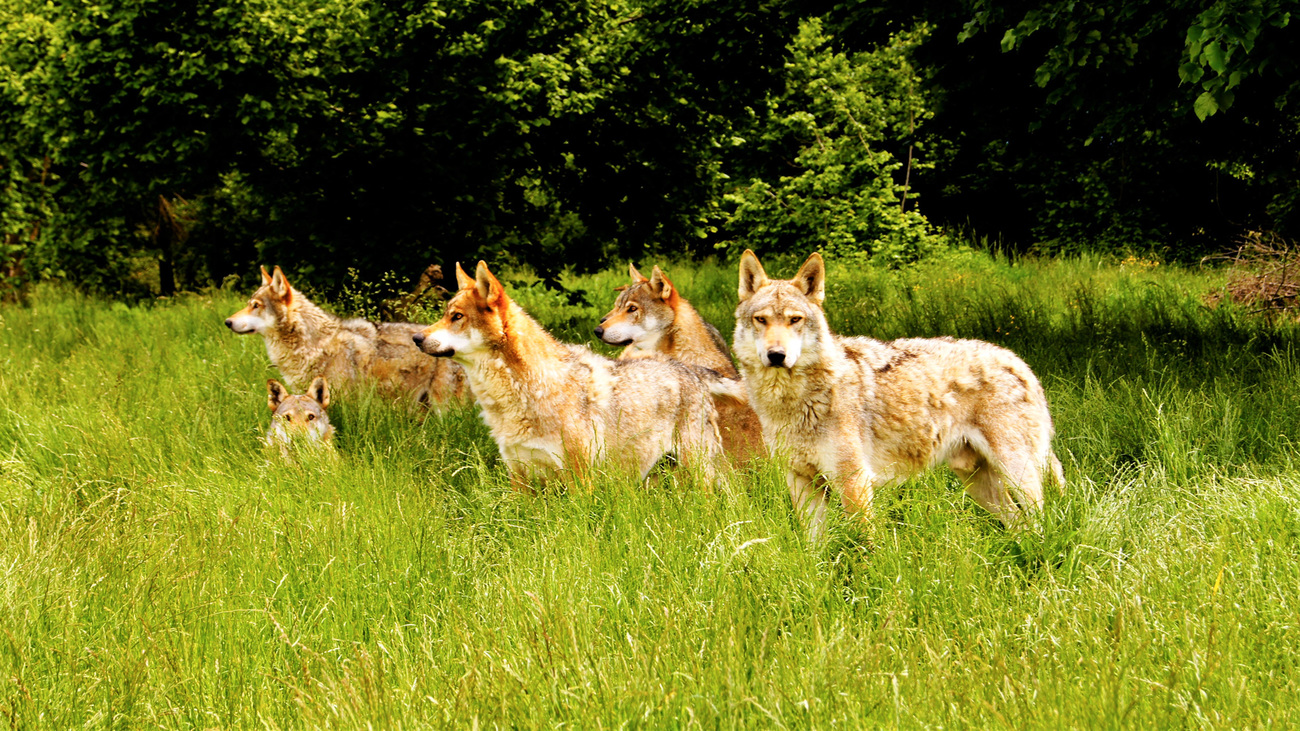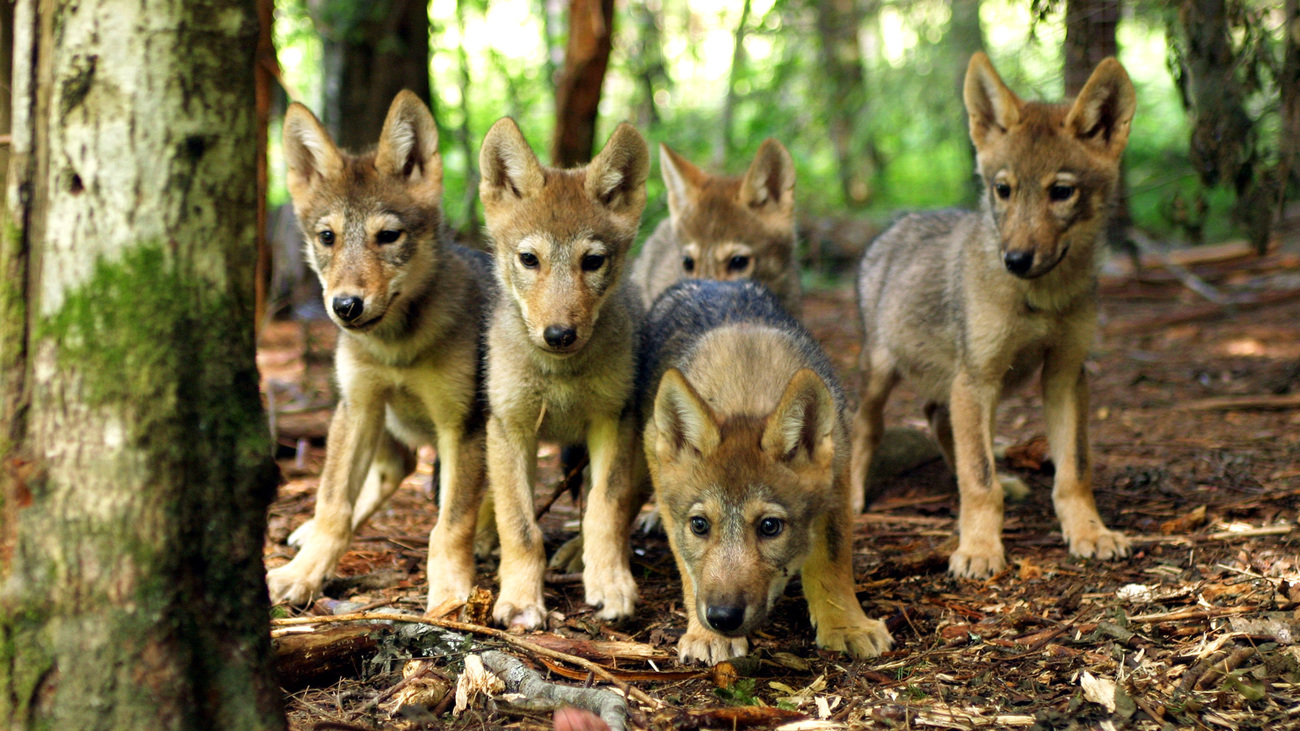Wolves
What is a wolf?
Wolves (Canis lupus) are members of the Canidae family and can be found across the Northern Hemisphere, in Europe, Asia, and North America. They are often referred to as grey wolves, though there are many recognised subspecies, each with a unique name and found in different habitats. These include the Arctic wolf, the Arabian wolf, and the Iberian wolf.
As highly social animals, wolves typically travel and hunt in packs of up to 30 members, targeting large herbivorous animals, such as moose, bison, elk, and oxen as prey. Each pack is led by a dominant alpha male and female. The male is responsible for guiding the pack in its travels, and the female is responsible for caring for and defending the pups.
The dominant pair mate between February and April, with litters of up to five or six pups arriving in the spring. Male wolves weigh 30 to 80 kilograms (65 to 175 pounds) on average and are between 130 and 205 centimetres (4.3 to 6.9 feet) long. Females weigh 23 to 55 kilograms (50 to 120 pounds) and are usually around 20% smaller than males.
Wolves are a keystone species and an apex predator in their ecosystems, meaning they help keep the number of prey species—and consequently the fauna and flora these species eat—in check. Because of their environmental importance, conservation and reintroduction projects are underway in certain areas where wolves have been hunted to near extinction.
What is a wolf’s scientific name?
The scientific name for wolves is Canis lupus, though each subspecies has its own scientific name too. This species, also called the grey wolf, is not to be confused with the red wolf (Canis rufus), which is found only in the southeastern US.
Europe is home to two subspecies of the grey wolf:
- The Iberian wolf, known scientifically as Canis lupus signatus, can be found in Iberia. It gets its scientific name from its distinct dark markings on its tail and legs and white markings on its upper lip. The Iberian wolf is slightly smaller than other European wolves.
- The Italian wolf, known scientifically as Canis lupus italicus, is found in Italy, France, and Switzerland. Its fur becomes redder during the summer, with dark bands on its back and tail tip.
There are two subspecies of wolves in Asia:
- The Indian wolf, known scientifically as Canis lupus pallipes, is the most common wolf in Asia. It can be found in most of Asia, from the Middle East to China. It’s also considerably smaller than its European counterparts and has shorter fur due to the warmer climate.
- The Arabian wolf, known scientifically as Canis lupus arabs, is found exclusively on the Arabian peninsula. This wolf subspecies boasts unique features—its two middle toes are fused together, and it has yellow or brown eyes. It is also the smallest subspecies of wolf.
North America is home to five subspecies of wolves:
- The Arctic wolf, known scientifically as Canis lupus arctos, can be found in Canada’s Queen Elizabeth Islands. It is often referred to as the ‘white’ or ‘polar’ wolf due to its lighter fur.
- The timber wolf, known scientifically as Canis lupus lycaon, can be found in the Great Lakes region and southeastern Canada. It has brown to reddish fur on its back and tail.
- The Great Plains wolf, known scientifically as Canis lupus nubilus, can be found throughout the Great Plains, stretching from southern Manitoba in Canada down to northern Texas. It is the most common subspecies of the grey wolf in North America.
- The northwestern or northern timber wolf, scientifically known as Canis lupus occidentalis, is found in Alaska, western Canada, and the northwestern US.
- The Mexican wolf, known as Canis lupus baileyi, is the rarest grey wolf subspecies and can be found in New Mexico in eastern Arizona. A small number have also been reintroduced in Sonora and Chihuahua in Mexico.
Another subspecies of the wolf is Canis lupus familiaris, otherwise known as the domestic dog. Today’s dogs we keep in our homes are descendants of wolves.
Are wolves endangered?
The grey wolf has been listed by the IUCN as least concern with a stable population since 1996. Previously, wolves were classified as vulnerable. This was due to large-scale habitat loss, as settlers transformed woodland into cities and farming pastures. Their decline was also fueled by predator control programmes designed to protect livestock.
Where do wolves live?
The grey wolf was once the most widely distributed mammal in the world, but its range today is 30% smaller than it once was. Wolves could previously be found throughout the Northern Hemisphere, but extensive and widespread eradication left them extinct in much of western Europe, Mexico, and the US. Wolves have gone extinct in some countries, such as Japan.
Wolves are now primarily found in the remote wilderness of the Northern Hemisphere, predominantly in Canada, Alaska, Europe, and Asia. Thanks to their varied diet—ranging from moose and wild boar to smaller prey like carrion and even domestic rubbish in urban areas—they can live in a range of habitats, including forests, shrublands, wetlands, grasslands, rocky areas, and deserts.
Threats
While wolves as a species are listed as least concern by the IUCN, they still face a wide range of threats, and some subspecies are more endangered than others. Factors that played a part in their original decline are still prevalent in areas where wolves don’t receive legal protections. Habitat loss is one of the most impactful issues wolves face, as woodlands are being destroyed to build new urban areas. Disease and human persecution also present a significant threat to wolf populations.

Habitat loss
As human populations continue to rise, the wolf’s natural habitat is increasingly being destroyed to make way for urban development and farmland. Deforestation and agricultural transformations have severely reduced the size of the wolf’s range.
Persecution
Humans are the leading cause of death for wolves in most areas. Farmers often persecute wolves to protect their livestock.
To keep wolves away from urban areas, people routinely poison, trap, and hunt them. This has led to their near extinction in much of their original range, and has directly contributed to their eradication in the UK and Japan, as well as their recent extinction in Andalusia.
Disease
While wolves have few natural predators other than humans, they are susceptible to diseases and parasites that affect other members of the canine genus. This includes canine parvovirus, rabies, Lyme disease, mange, and heartworm.
FAQs
How many wolves are in a pack?
On average, a wolf pack has six to seven members. However, the pack’s size can vary depending on the subspecies, ranging from two to 30 members. Some wolves—like the timber wolf—prefer to be in a large pack, while others—such as the Arabian wolf—tend to be less social.
Where do wolves live?
Wolves were once the world’s most widely distributed mammal and could be found across the entire Northern Hemisphere. However, their geographic range has shrunk considerably due to a range of threats.
Following their extinction in much of Western Europe, Mexico, and the US—and all of Japan—wolves are now typically only found in remote areas and wilderness. Currently, wolves can still be spotted in Asia, parts of Europe, and parts of North America.

What do wolves eat?
Though it is commonly thought that wolves target livestock—leading to a strong distrust of the species from farmers looking to protect their livelihoods—wolves that live near livestock rarely kill them.
Instead, wolves mainly hunt and eat large herbivores, which they attack as a pack, using speed and numbers to take down prey much larger than themselves. Wolves also focus their hunting efforts on younger and older animals that are more vulnerable and thus easier to attack. Common prey include deer, elk, moose, bison, bighorn sheep, caribou, and musk oxen. Wolves have also been known to eat smaller mammals, such as beavers and hares, while wolves in western Canada often fish for Pacific salmon.
How fast can wolves run?
Wolves can reach running speeds of up to 60 kilometres per hour (37 miles per hour) when pursuing prey. The Arctic wolf is the fastest grey wolf subspecies, with a highest recorded speed of 74 kilometres per hour (46 miles per hour).
Are wolves nocturnal?
Wolves do move around and hunt at night, though they are not strictly nocturnal. Typically, they display crepuscular behaviour, meaning they prefer times of low light and are most active around twilight, dawn, and dusk. This is due to the tapetum lucidum in their eyes, a reflective layer that allows wolves to see well in low-light conditions.
Are wolves endangered?
Wolves are not endangered. They were classed as vulnerable by the IUCN until 1996 when their classification was lowered to lower risk/least concern. They were reclassified as least concern in 2004.
Despite the status of the species as a whole, some wolf subspecies are endangered or threatened.
- The Arabian wolf is listed as endangered
- The Himalayan wolf is listed as vulnerable
- The Indian wolf is considered endangered under India’s Wildlife Protection Act (1972)
- The Iberian wolf is listed as vulnerable
Are coyotes wolves?
Coyotes (Canis latrans) are often mistaken for wolves as they are both members of the canine family and are similar in appearance. However, coyotes and wolves are distinct species. Key differences include size—with wolves being considerably larger—and vocalisations.
Coyotes are only found in North and Central America, sharing space with the Great Plains wolf. However, they are not often seen together, especially during the summer when coyotes tend to avoid wolves and the areas they occupy.
How long do wolves live?
Wolves in the wild can live for up to 13 years. However, most die before that age due to various threats, including disease. Wolves in captivity have been known to live for up to 17 years.
How big are wolves?
On average, a male wolf weighs between 30 and 80 kilograms (65 and 175 pounds) and is between 130 and 205 centimetres (4.3 and 6.9 feet) long. Females are smaller than their male counterparts, ranging from 23 to 55 kilograms (50 to 120 pounds). They are typically 20% smaller than males.
How far do grey wolves migrate?
Grey wolves do not migrate. However, they do travel long distances while hunting or looking for a mate and have been known to travel up to 48 kilometres (30 miles) per day.
Are wolves extinct in the UK?
Wolves were hunted to extinction in the UK during the 18th century. There are no current plans for reintroduction.
Why do wolves howl?
Wolves howl to communicate, much like how dogs bark. These howls can be social vocalisations, hunting calls, or used for territorial expression.
Are wolves dangerous to humans?
Wolves are not typically dangerous to humans. Research conducted between 2002 and 2020 found that the risk of danger was not zero, but ‘far too low to calculate’. However, humans should still maintain a safe distance and not interfere with wolves in the wild.
Our work
In Canada and the US, IFAW is supporting legislation and regulations that would stop the use of the poisons such as sodium cyanide, strychnine, and Compound 1080 to kill wolves and other species. The use of these poisons is inhumane and unethical, as they cause intense suffering and a prolonged, painful death. In addition to being cruel, ecologically disruptive, and dangerous to the public, research shows that killing wolves is ineffective as a long-term means of reducing livestock predation.
In contrast, wolves are strictly protected in the EU, and packs have started to repopulate certain parts of their historic range. They have established themselves in parts of Germany, Netherlands, Belgium, Austria, and Switzerland. In Europe, our work has helped to raise public awareness and enable coexistence. We help monitor wolf activity in Germany to help humans acclimatise to the reintroduction of wolves in their country.
Populations in both North America and Europe, though recovering, will need ongoing protection before they—and the ecological services they provide—are truly sustainable.

How can you help?
Humans pose a bigger threat to wolves than anything else. To help protect them, we are working hard to educate people on how wolves and humans can coexist.
